I haven't provided detailed commentary on the US labour market for a while now. To…
Australian labour market – a relatively stronger result for August 2017
The latest labour force data released today by the Australian Bureau of Statistics – Labour Force data – for August 2017 shows that total employment growth was relatively robust (up 54,200) with full-time employment growth accounting for much of that increase. Unlike recent months, where if full-time growth was positive, part-time growth was negative (and vice versa), both components of employment rose. Further, the participation rate rose by 0.2 points as job opportunities expanded. Labour underutilisation overall (underemployment and unemployment) was at 14.1 per cent summing to 1,842.8 thousand persons. The teenage labour market showed further improvement but remains in a poor state. Overall, my assessment of the Australian labour market is that it still to early to conclude that the uncertainty of the last few years is giving way to sustained growth.
The summary ABS Labour Force (seasonally adjusted) estimates for August 2017 are:
- Employment increased by 54,200 (0.5 per cent) – full-time employment increased 40,100 and part-time employment increased 14,100.
- Unemployment decreased 1,100 to 727,500.
- The official unemployment rate remained steady at 5.6 per cent.
- The participation rate increased by 0.2 pts to 65.3 per cent. It still remains below its December 2010 peak (recent) of 65.8 per cent.
- Aggregate monthly hours worked increased 6.1 million hours (0.4 per cent).
- Using the seasonally-unadjusted quarterly data, the total labour underutilisation rate (unemployment plus underemployment) was 14.1 per cent (1,812.6 thousand workers). Underemployment was 8.5 per cent and there were 1,101.3 thousand persons underemployed.
Employment growth – stronger in August
Employment increased by 54,200 (0.5 per cent) – full-time employment increased 40,100 and part-time employment increased 14,100.
This is a relatively strong result.
We have observed a zig-zag pattern in total employment growth over the last 36 months or so – where the employment estimates have been switching back and forth regularly between negative employment growth and positive growth with the occasional spikes.
This month, the pattern where full-time or part-time would alternative with negative and positive growth changed with both recording positive movements.
The following graph shows the month by month growth in full-time (blue columns), part-time (grey columns) and total employment (green line) for the 24 months to August 2017 using seasonally adjusted data.
It gives you a good impression of just how flat employment growth has been over the last 2 years. The positive note is that there has been four stronger full-time employment outcomes in the last eight months.
The following table provides an accounting summary of the labour market performance over the last six months. The monthly data is highly variable so this Table provides a longer view which allows for a better assessment of the trends.
Full-time employment has risen risen by 211.9 thousand jobs (net) over the last 6 months, while part-time employment has risen by 38.9 thousand jobs.
The conclusion – overall there have been 250.8 thousand jobs (net) added in Australia over the last six months while the labour force has increased by 230.1 thousand. The result has been that unemployment has fallen by 20.7 thousand.
Overall – an improving labour market performance, especially given the growth of the labour force as a result of two successive increases in the participation rate.
Given the variation in the labour force estimates, it is sometimes useful to examine the Employment-to-Population ratio (%) because the underlying population estimates (denominator) are less cyclical and subject to variation than the labour force estimates. This is an alternative measure of the robustness of activity to the unemployment rate, which is sensitive to those labour force swings.
The following graph shows the Employment-to-Population ratio, since February 2008 (the low-point unemployment rate of the last cycle).
It dived with the onset of the GFC, recovered under the boost provided by the fiscal stimulus packages but then went backwards again as the last Federal government imposed fiscal austerity in a hare-brained attempt at achieving a fiscal surplus.
The ratio began rising in December 2014 which suggested to some that the labour market had bottomed out and would improve slowly as long as there are no major policy contractions or cuts in private capital formation.
The series turned again as overall economic activity weakened. Over the last few months it has improved again.
The series rose by 0.2 points in August 2017 to 61.6 per cent and remains a 1.3 percentage points below the April 2008 peak of 62.9 per cent.
In recent months, the ratio has risen quite quickly which is a good sign.
Teenage labour market – further improvement in August 2017
The stronger overall labour market position has not really filtered down to the teenage segment.
Despite the stronger full-time employment growth overall, full-time teenage employment fell by 0.2 thousand jobs in August 2017, while part-time employment rose by 7.1 thousand.
As a result, total employment rose by 7 thousand (net) in August 2017.
The following graph shows the distribution of net employment creation in the last month by full-time/part-time status and age/gender category (15-19 year olds and the rest)
Over the last 12 months, teenagers have lost 0.2 thousand (net) jobs overall while the rest of the labour force have gained 325.8 thousand net jobs.
Full-time employment for teenagers over the last 12 months has risen by 8.8 thousand while part-time employment employment has fallen by 9 thousand.
The following graph shows the change in aggregates over the last 12 months.
In terms of the current cycle, which began after the last low-point unemployment rate month (February 2008), the following results are relevant:
1. Since February 2008, there have been only 1,621.4 thousand (net) jobs added to the Australian economy but teenagers have lost a staggering 93.3 thousand over the same period.
2. Since February 2008, teenagers have lost 117.5 thousand full-time jobs (net).
3. Even in the traditionally, concentrated teenage segment – part-time employment, teenagers have gained only 24.2 thousand jobs (net) even though 870.2 thousand part-time jobs have been added overall.
To put the teenage employment situation in a scale context (relative to their size in the population) the following graph shows the Employment-Population ratios for males, females and total 15-19 year olds since February 2008.
You can interpret this graph as depicting the loss of employment relative to the underlying population of each cohort. We would expect (at least) that this ratio should be constant if not rising somewhat (depending on school participation rates).
The facts are that the absolute loss of jobs reported above is depicting a very difficult situation for our teenagers. Males, in particular, have lost out severely as a result of the economy being deliberately stifled by austerity policy positions.
In the latter months of 2015, with the part-time employment situation improving, there was some reversal in the downward trends in these ratios.
However, in recent months the ratios have fallen again, with a slight pickup in July.
The male ratio has fallen by 11.6 percentage points since February 2008, the female ratio has fallen by 4.7 percentage points and the overall teenage employment-population ratio has fallen by 8.2 percentage points.
That is a substantial decline in the employment market for Australian teenagers.
The other staggering statistic relating to the teenage labour market is the decline in the participation rate since the beginning of 2008 when it peaked in January at 61.4 per cent. In August 2017, the participation rate rose 0.7 points to 53.8 per cent.
That amounts to an additional 114.8 thousand teenagers who have dropped out of the labour force as a result of the weak conditions since the crisis.
If we added them back into the labour force the teenage unemployment rate would be 28.2 per cent rather than the official estimate for August 2017 of 18 per cent.
Some may have decided to return to full-time education and abandoned their plans to work. But the data suggests the official unemployment rate is significantly understating the actual situation that teenagers face in the Australian labour market.
Overall, the performance of the teenage labour market remains extremely poor. It doesn’t rate much priority in the policy debate, which is surprising given that this is our future workforce in an ageing population. Future productivity growth will determine whether the ageing population enjoys a higher standard of living than now or goes backwards.
I continue to recommend that the Australian government immediately announce a major public sector job creation program aimed at employing all the unemployed 15-19 year olds, who are not in full-time education or a credible apprenticeship program.
Unemployment decreased 1,100 to 727,500
The official unemployment rate remained steady at 5.6 per cent in August 2017.
The labour market still has significant excess capacity available.
The following graph shows the national unemployment rate from February 1978 to August 2017. The longer time-series helps frame some perspective to what is happening at present.
After falling steadily as the fiscal stimulus pushed growth along, the unemployment rate slowly trended up for some months.
It is now still 0.6 points above the level it fell to as a result of the fiscal stimulus and 1.6 points above the level reached before the GFC began.
Broad labour underutilisation – at 14.1 per cent
The ABS publishes monthly and quarterly labour underutilisation data. The quarterly data was updated this month (for the August-quarter 2017):
1. Underemployment was estimated to be 8.6 per cent of the labour force (slightly down on the May-quarter).
2. The total labour underutilisation rate (unemployment plus underemployment) was 14.1 per cent.
3. There were 1,115.3 thousand persons underemployed and a total of 1,842.8 thousand workers either unemployed or underemployed.
The following graph plots the history of quarterly (seasonally-adjusted) underemployment in Australia since February 1978 to the May-quarter 2017.
The next graph shows the evolution of the broad underutilisation rate over the same period. You can see the three cyclical peaks corresponding to the 1982, 1991 recessions and the more recent downturn.
Unemployment was a higher proportion of the two earlier peaks but underemployment now dominates the current cycle (just).
The other difference between now and the two earlier cycles is that the recovery triggered by the fiscal stimulus in 2008-09 did not persist and as soon as the ‘fiscal surplus’ fetish kicked in in 2012, things went backwards very quickly.
The two earlier peaks were sharp but steadily declined. The last peak fell away on the back of the stimulus but turned again when the stimulus was withdrawn.
If hidden unemployment (given the depressed participation rate) is added to the broad ABS figure the best-case (conservative) scenario would see a underutilisation rate well above 16 per cent at present. Please read my blog – Australian labour underutilisation rate is at least 13.4 per cent – for more discussion on this point.
The next update will be for the November-quarter 2017 and will be published published in the December 2017 Labour Force release. In between those releases, the monthly estimates guide our thinking.
Aggregate participation rate – rises by 0.2 points to 65.3 per cent
While the participation rate edged up again in August 2017, it remains below the most recent peak in November 2010 of 65.8 per cent when the labour market was still recovering courtesy of the fiscal stimulus.
What would the unemployment rate be if the participation rate was at the last November 2010 peak level value?
The following graph tells us what would have happened if the participation rate had been constant over the period November 2010 to August 2017. The blue line is the official unemployment rate since its most recent low-point of 4 per cent in February 2008.
The red line starts at November 2010 (the peak participation month). It is computed by adding the workers that left the labour force as employment growth faltered (and the participation rate fell) back into the labour force and assuming they would have been unemployed. At present, this cohort is likely to comprise a component of the hidden unemployed (or discouraged workers).
With the rise in participation in recent months, the red line is dropping quite sharply, which is a good sign.
1. Total official unemployment in August 2017 was estimated to be 727.5 thousand.
2. Unemployment would be 831.7 thousand if participation rate was at its November 2010 peak.
3. The unemployment rate would now be 6.3 per cent rather than the official August 2017 estimate of 5.6 per cent.
The difference between the two numbers mostly reflects, the change in hidden unemployment (discouraged workers) since November 2010. These workers would take a job immediately if offered one but have given up looking because there are not enough jobs and as a consequence the ABS classifies them as being Not in the Labour Force.
There has been some change in the age composition of the labour force (older workers with low participation rates becoming a higher proportion) but this only accounts for less than 1/3 of the shift. The rest is undoubtedly accounted for by the rise in hidden unemployment.
Note, the gap between the blue and red lines doesn’t sum to total hidden unemployment unless November 2010 was a full employment peak, which it clearly was not. The interpretation of the gap is that it shows the extra hidden unemployed since that time.
This gap shrinks as participation rises relative to the November 2010 peak.
Hours worked – increased 6.1 million hours (0.4 per cent)
Over the last three months we have seen swings in both directions.
The following graph shows the monthly growth (in per cent) over the last 24 months. The dark linear line is a simple regression trend of the monthly change – which depicts an upward trend – driven mostly by the outlier in May 2017.
You can see the pattern of the change in working hours is also portrayed in the employment graph – zig-zagging across the zero growth line.
Conclusion
My standard monthly warning: we always have to be careful interpreting month to month movements given the way the Labour Force Survey is constructed and implemented.
Today’s figures show that the Australian labour market improved again in August 2017, if we consider positive overall employment growth to be the benchmark.
The net result was relatively strong and was accompanied by a rise in full-time work (reversing last month’s result).
Unemployment fell even though the participation rose. That suggests that employment growth was robust.
There was a slight improvement in the teenage labour market in August 2017, but it remains in a poor state.
Overall, the state of the Australian labour market still remains uncertain although the positive employment growth is a good sign.
Reclaiming the State Lecture Tour – September-October, 2017
For up to date details of my upcoming book promotion and lecture tour in Late September and early October through Europe go to – The Reclaim the State Project homePage.
For sale – Just released book at discount price
I have stock of the book (paperback version) available for sale at discounted prices, well below the current market price from the booksellers.
If you would like a copy signed by yours truly then you should send me an E-mail me (Bill.Mitchell – @ – newcastle.edu.au deleting the – and space before and after the @ sign) with your location and I will send you PayPal details plus postage costs.
The discounted price I can make the book available (while my stock lasts) is plus postage.
My stocks are limited.
That is enough for today!
(c) Copyright 2017 William Mitchell. All Rights Reserved.
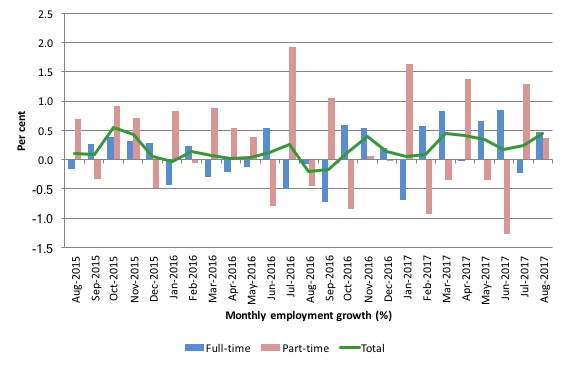
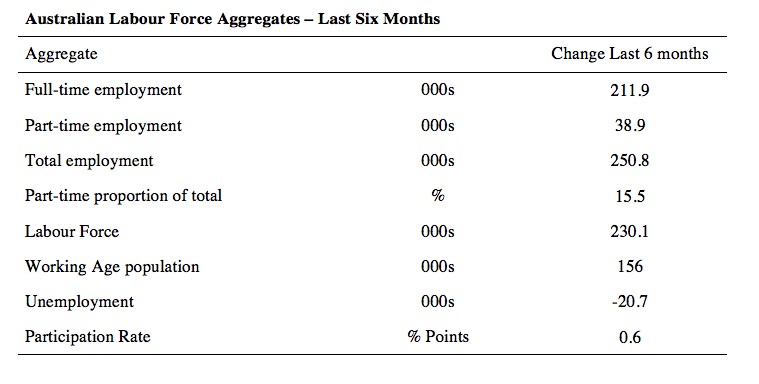
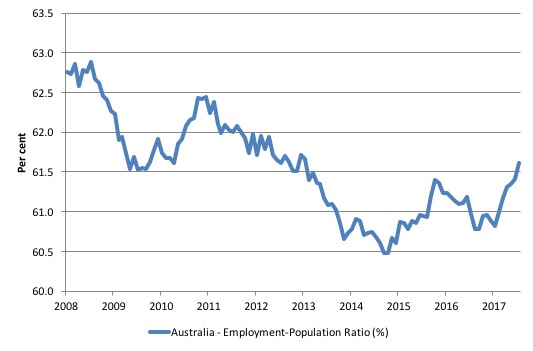
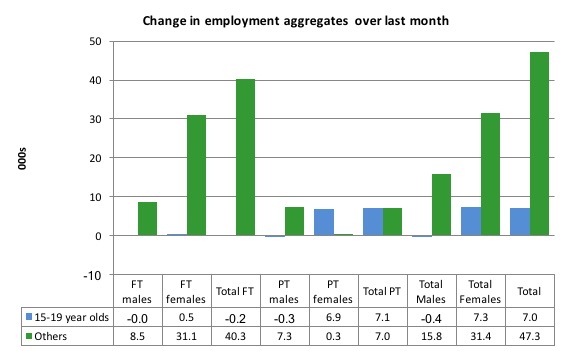
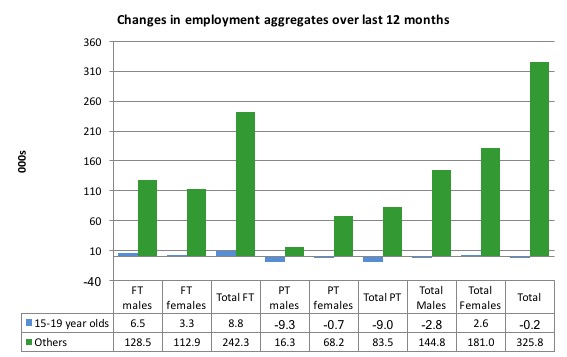
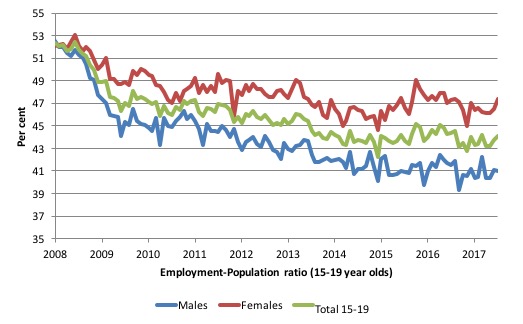
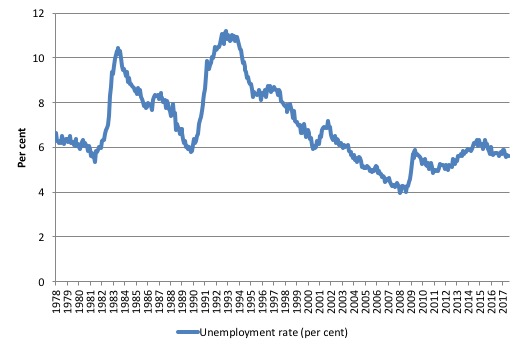
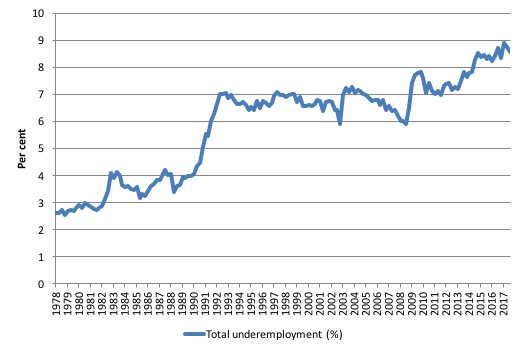
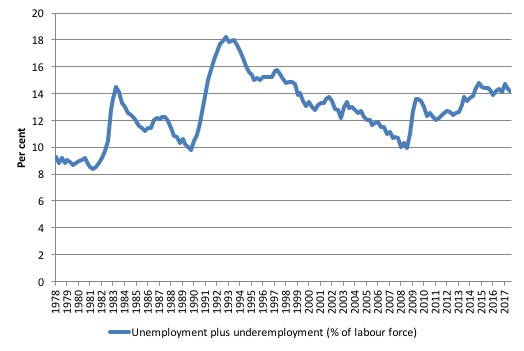
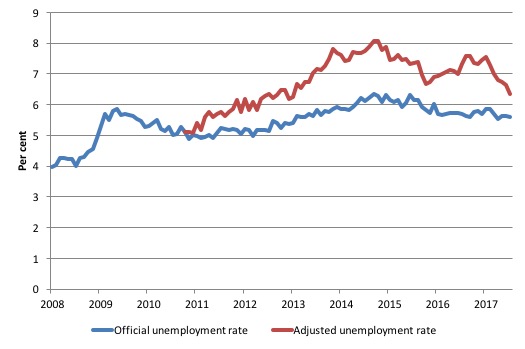
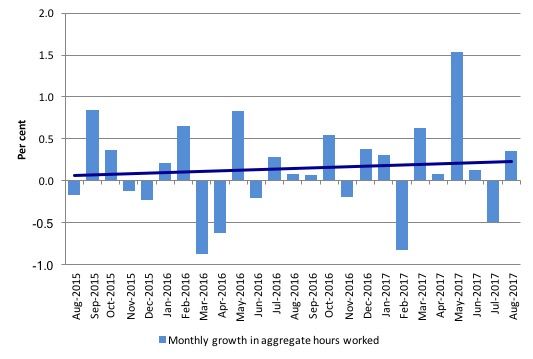
Wasnt low GDP growth meant to mean that it would kn t sustained employment growth ???
As seems to be usually the case, the Australian economy keeps growing on a combination of factors that keep beating off the possibility of negative growth.
The jobs market seems to be responding to a large surge in spending by state governments, filtering through to much of the economy – spending is spending and business does not care if it was private or public, it all becomes revenue for them. Plus households returning to the pre-GFC behaviour of decimating their savings.
The situation is clear – government spending works! Too bad that the current surge is only going to be sustained another 12 months or so at present.